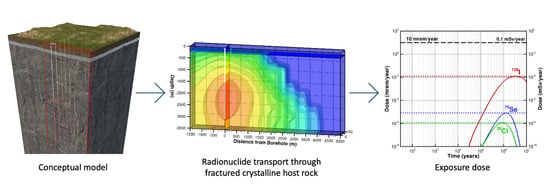Post-Closure Safety Analysis of Nuclear Waste Disposal in Deep Vertical Boreholes
Abstract
1. Introduction
2. Methodology
3. Model Development
3.1. Repository Layout
3.2. Computational Grid
3.3. Radionuclide Inventory and Waste Mobilization
3.4. Engineered Barrier System
3.5. Natural Barrier System
3.6. Processes and Parameters
3.7. Initial and Boundary Conditions
4. Simulation Results
4.1. Reference Scenario
4.2. Sensitivity Analyses
5. Summary and Concluding Remarks
- Fluid flow at the depth of a vertical borehole repository is very slow, mainly because (a) permeabilities tend to decrease with depth, (b) hydrological perturbations driven by near-surface processes do not reach the disposal section, and (c) the pressure field is stabilized due to density stratification of the brine.
- Radionuclide migration times from the disposal section to the accessible environment are very long mainly because of (a) long travel distances, (b) the absence of strong driving forces needed to induce advective transport, (c) matrix diffusion, and (d) sorption.
- The peak exposure dose calculated for the generic repository system and related reference scenario is significantly below a stringent dose standard of 0.1 mSv yr−1.
- Thermal effects and the impact of incomplete borehole sealing on overall repository performance are minor, even for an early canister failure scenario.
- It is recommended that both the exposure dose, which is the ultimate metric of repository performance, and intermediate results used to demonstrate the behavior of individual barrier components, be calculated using a comprehensive model of sufficient complexity, capable of accounting for key features and processes as well as the relevant interactions among all elements of the repository system.
Author Contributions
Funding
Institutional Review Board Statement
Informed Consent Statement
Data Availability Statement
Acknowledgments
Conflicts of Interest
References
- National Research Council. The Disposal of Radioactive Waste on Land; National Academy of Sciences: Washington, DC, USA, 1957; p. 153. [Google Scholar]
- O’Brien, M.T.; Cohen, L.H.; Narasimhan, T.N.; Simkin, T.L.; Wollenberg, H.A.; Brace, W.F.; Green, S.; Pratt, H.P. The Very Deep Hole Concept: Evaluation of an Alternative for Nuclear Waste Disposal; Lawrence Berkeley Laboratory: Berkeley, CA, USA, 1979; p. 59. [Google Scholar]
- Woodward-Clyde Consultants. Very Deep Hole Systems Engineering Studies; Office of Nuclear Waste Isolation, Battelle Memorial Institute: Columbus, OH, USA, 1983; p. 352. [Google Scholar]
- Juhlin, C.; Sandstedt, H. Storage of Nuclear Waste in Very Deep Boreholes: Feasibility Study and Assessment of Economic Potential; Svensk Kärnbränslehantering AB (SKB): Stockholm, Sweden, 1989; p. 245. [Google Scholar]
- Nirex. A Review of the Deep Borehole Disposal Concept for Radioactive Waste; United Kingdom Nirex Limited: Harwell, UK, 2004; p. 89. [Google Scholar]
- Brady, P.V.; Arnold, B.W.; Freeze, G.A.; Swift, P.N.; Bauer, S.J.; Kanney, J.L.; Rechard, R.P.; Stein, J.S. Deep Borehole Disposal of High-Level Radioactive Waste; Sandia National Laboratories: Albuquerque, NM, USA, 2009; p. 75. [Google Scholar]
- Arnold, B.W.; Brady, P.; Altman, S.; Vaughn, P.; Nielson, D.; Lee, J.; Gibb, F.; Mariner, P.; Travis, K.; Halsey, W.; et al. Deep Borehole Disposal Research: Demonstration Site Selection Guidelines, Borehole Seals Design, and RD&D Needs; Sandia National Laboratories: Albuquerque, NM, USA, 2013; p. 221. [Google Scholar]
- Arnold, B.W.; Brady, P.; Sutton, M.; Travis, K.; MacKinnon, R.; Gibb, F.; Greenberg, H. Deep Borehole Disposal Research: Geological Data Evaluation; Alternative Waste Forms and Borehole Seals; Sandia National Laboratories: Albuquerque, NM, USA, 2014; p. 116. [Google Scholar]
- Freeze, G.; Stein, E.; Brady, P.V.; Lopez, C.; Sassani, D. Deep Borehole Disposal Safety Case; Sandia National Laboratories: Albuquerque, NM, USA, 2019; p. 94. [Google Scholar]
- Beswick, A.J.; Gibb, F.G.F.; Travis, K.P. Deep borehole disposal of nuclear waste: Engineering challenges. Proc. Inst. Civ. Eng. Energy 2014, 167, 47–66. [Google Scholar] [CrossRef]
- Bates, E.A. Optimization of Deep Boreholes for Disposal of High-Level Nuclear Waste; Massachusetts Institute of Technology: Cambridge, MA, USA, 2015. [Google Scholar]
- Gibb, F.G.F. High-temperature, very deep, geological disposal: A safer alternative for high-level radioactive waste? Waste Manag. 1999, 19, 207–211. [Google Scholar] [CrossRef]
- International Atomic Energy Agency (IAEA). Underground Disposal Concepts for Small Inventories of Intermediate and High Level Radioactive Waste; International Atomic Energy Agency (IAEA): Vienna, Austria, 2020; p. 94. [Google Scholar]
- Chapman, N.A. Who Might Be Interested in a Deep Borehole Disposal Facility for Their Radioactive Waste? Energies 2019, 12, 13. [Google Scholar] [CrossRef]
- Electric Power Research Institute (EPRI). Feasibility of Borehole Co-Location with Advanced Reactors for Onsite Management of Spent Nuclear Fuel; EPRI: Palo Alto, CA, USA, 2020; p. 192. [Google Scholar]
- Arnold, B.W.; Brady, P.V.; Bauer, S.J.; Herrick, C.; Pye, S.; Finger, J. Reference Design and Operations for Deep Borehole Disposal of High-Level Radioactive Waste; Sandia National Laboratories: Albuquerque, NM, USA, 2011; p. 67. [Google Scholar]
- Muller, R.A.; Finsterle, S.; Grimsich, J.; Baltzer, R.; Muller, E.A.; Rector, J.W.; Payer, J.; Apps, J. Disposal of High-Level Nuclear Waste in Deep Horizontal Drillholes. Energies 2019, 12, 28. [Google Scholar] [CrossRef]
- Finsterle, S.; Muller, R.A.; Baltzer, R.; Payer, J.; Rector, J.W. Thermal Evolution near Heat-Generating Nuclear Waste Canisters Disposed in Horizontal Drillholes. Energies 2019, 12, 23. [Google Scholar] [CrossRef]
- Finsterle, S.; Muller, R.A.; Grimsich, J.; Apps, J.; Baltzer, R. Post-Closure Safety Calculations for the Disposal of Spent Nuclear Fuel in a Generic Horizontal Drillhole Repository. Energies 2020, 13, 31. [Google Scholar] [CrossRef]
- Finsterle, S.; Cooper, C.; Muller, R.A.; Grimsich, J.; Apps, J. Sealing of a Deep Horizontal Borehole Repository for Nuclear Waste. Energies 2021, 14, 91. [Google Scholar] [CrossRef]
- Cotton, M. Deep borehole disposal of nuclear waste: Trust, cost and social acceptability. J. Risk Res. 2021, 1–16. [Google Scholar] [CrossRef]
- Svensk Kärnbränslehantering AB (SKB). Choice of Method—Evaluation of Strategies and Systems for Disposal of Spent Nuclear Fuel; Svensk Kärnbränslehantering AB (SKB): Stockholm, Sweden, 2010. [Google Scholar]
- Kochkin, B.; Malkovsky, V.; Yudintsev, S.; Petrov, V.; Ojovan, M. Problems and perspectives of borehole disposal of radioactive waste. Prog. Nucl. Energy 2021, 139, 1–9. [Google Scholar] [CrossRef]
- Bates, E.A.; Driscoll, M.J.; Lester, R.K.; Arnold, B.W. Can deep boreholes solve America’s nuclear waste problem? Energy Policy 2014, 72, 186–189. [Google Scholar] [CrossRef]
- International Atomic Energy Agency (IAEA). Disposal of Radioactive Waste, Specific Safety Requirements, SSR-5; IAEA: Vienna, Austria, 2011; p. 83. [Google Scholar]
- Nuclear Energy Agency (NEA). The Nature and Purpose of the Post-Closure Safety Cases for Geological Repositories; NEA/RWM: Paris, France, 2013; p. 55. [Google Scholar]
- International Atomic Energy Agency (IAEA). IAEA Safety Glossary, Terminology Used in Nuclear Safety and Radiation Protection; IAEA: Vienna, Austria, 2019; p. 278. [Google Scholar]
- Freeze, G.; Voegele, M.; Vaughn, P.; Prouty, J.; Nutt, W.M.; Hardin, E.; Sevougian, S.D. Generic Deep Disposal Safety Case; Sandia National Laboratories: Albuquerque, NM, USA, 2013; p. 372. [Google Scholar]
- Freeze, G.; Stein, E.; Price, L.; MacKinnon, R.; Tillman, J. Deep Borehole Disposal Safety Analysis; Sandia National Laboratories: Albuquerque, NM, USA, 2016; p. 274. [Google Scholar]
- Sandia National Laboratories (SNL). Deep Borehole Field Test Conceptual Design Report; Sandia National Laboratories: Albuquerque, NM, USA, 2016; p. 312. [Google Scholar]
- Bracke, G.; Kudla, W.; Rosenzweig, T. Status of Deep Borehole Disposal of High-Level Radioactive Waste in Germany. Energies 2019, 12, 2580. [Google Scholar] [CrossRef]
- Finsterle, S.; Commer, M.; Edmiston, J.K.; Jung, Y.; Kowalsky, M.B.; Pau, G.S.H.; Wainwright, H.M.; Zhang, Y. iTOUGH2: A multiphysics simulation-optimization framework for analyzing subsurface systems. Comput. Geosci. 2017, 108, 8–20. [Google Scholar] [CrossRef]
- Pruess, K. TOUGH2 User’s Guide, Version 2.1; Lawrence Berkeley National Laboratory: Berkeley, CA, USA, 2012; p. 210. [Google Scholar]
- Finsterle, S. iTOUGH2-EOS1nT: A Nonisothermal Two-Phase Flow Simulator for Water and Multiple Tracers—User’s Guide; Finsterle GeoConsulting: Kensington, CA, USA, 2019; p. 35. [Google Scholar]
- Pruess, K. The TOUGH codes—A family of simulation tools for multiphase flow and transport processes in permeable media. Vadose Zone J. 2004, 3, 738–746. [Google Scholar]
- Finsterle, S.; Sonnenthal, E.L.; Spycher, N. Advances in subsurface modeling using the TOUGH suite of simulators. Comput. Geosci. 2014, 65, 2–12. [Google Scholar] [CrossRef]
- Warren, J.E.; Root, P.J. The Behavior of Naturally Fractured Reservoirs. Soc. Pet. Eng. J. 1963, 3, 245–255. [Google Scholar] [CrossRef]
- Pruess, K.; Narasimhan, T.N. On fluid reserves and the production of superheated steam from fractured, vapor-dominated geothermal reservoirs. J. Geophys. Res. Solid Earth 1982, 87, 9329–9339. [Google Scholar] [CrossRef]
- Pruess, K.; Narasimhan, T. A practical method for modeling fluid and heat flow in fractured porous media. Soc. Pet. Eng. J. 1985, 25, 14–26. [Google Scholar] [CrossRef]
- DOE/OCRWM. Yucca Mountain Repository License Application: Safety Analysis Report; DOE/RW-0573, Update No. 1; U.S. Department of Energy, Office of Civilian Radioactive Waste Management: Las Vegas, NV, USA, 2008; Chapter 2; p. 194. [Google Scholar]
- IAEA. “Reference Biospheres” for Solid Radioactive Waste Disposal; International Atomic Energy Agency: Vienna, Austria, 2003. [Google Scholar]
- Deep Isolation. Spent Nuclear Fuel Disposal in a Deep Horizontal Drillhole Repository Sited in Shale: Numerical Simulations in Support of a Generic Post-Closure Safety Analysis; Deep Isolation, Inc.: Berkeley, CA, USA, 2020; p. 149. [Google Scholar]
- Forsberg, C.W. Rethinking high-level waste disposal: Separate disposal of high-heat radionuclides (Sr-90 and Cs-137). Nucl. Technol. 2000, 131, 252–268. [Google Scholar] [CrossRef]
- Freeze, G.A.; Stein, E.; Brady, P.V.; Lopez, C.; Sassani, D.; Travis, K.; Gibb, F.; Beswick, J. Deep Borehole Disposal Safety Case. Energies 2019, 12, 21. [Google Scholar] [CrossRef]
- Rigali, M.J.; Pye, S.; Hardin, E.L. Large Diameter Deep Borehole (LDDB) Disposal Design Option for Vitrified High-Level Waste (HLW) and Granular Waste; Sandia National Laboratories: Albuquerque, NM, USA, 2016; p. 28. [Google Scholar]
- Gibbs, J.S. Feasibility of Lateral Emplacement in Deep Borehole Disposal of High Level Nuclear Waste; Massachussets Institute of Technology: Cambridge, MA, USA, 2010. [Google Scholar]
- Aadnøy, B.S.; Dusseault, M.B. Deep Borehole Placement of Radioactive Wastes—A Feasibility Study; Norwegian Nuclear Decommissioning (NND): Halden, Norway, 2020; p. 226. [Google Scholar]
- Randeberg, E.; Ford, E.; Nygaard, G.; Eriksson, M.; Gressgård, L.; Hansen, K. Potentials for cost reduction for geothermal well construction in view of various drilling technologies and automation opportunities. In Proceedings of the Thirty-Sixth Workshop on Geothermal Reservoir Engineering, Stanford University, Stanford, CA, USA, 30 January–1 February 2012; p. SGP-TR-194. [Google Scholar]
- Baldwin, T.; Chapman, N.; Neall, F. Geological Disposal Options for High-Level Waste and Spent Fuel; Radioactive Waste Management (RWM): Didcot, UK; Nuclear Decommissioning Agency (NDA): Moor Row, UK, 2018; p. 125. [Google Scholar]
- DOE/OCRWM. Yucca Mountain Repository License Application: General Information; U.S. Department of Energy Office of Civilian Radioactive Waste Management: Las Vegas, NV, USA, 2008. [Google Scholar]
- Easterling, D. Fair rules for siting a high-level nuclear waste repository. J. Policy Anal. Manag. 1992, 11, 442–475. [Google Scholar] [CrossRef]
- Kasperson, R.E.; Rubin, B.L. Siting a Radioactive Waste Repository: What Role for Equity. In Equity Issues in Radioactive Waste Management; Kasperson, R.E., Ed.; Oelgeschlager, Gunn and Hain, Publishers, Inc.: Cambridge, MA, USA, 1984; pp. 118–136. [Google Scholar]
- Tóth, J. Gravitational Systems of Groundwater Flow-Theory, Evaluation Utilization; Cambridge University Press: Cambridge, UK, 2009. [Google Scholar]
- Hutton, D.V. Fundamentals of Finite Element Analysis; McGraw-Hill: Boston, MA, USA, 2004; p. 494. [Google Scholar]
- Nagra. Project Opalinus Clay, Safety Report, Demonstration of Disposal Feasibility for Spent Fuel, Vitrified High-Level Waste and Long-Lived Intermediate-Level Waste (Entsorgungsnachweis); National Cooperative for the Disposal of Radioactive Waste (Nagra): Wettingen, Switzerland, 2002; p. 472. [Google Scholar]
- Andra. Dossier 2005 Argile: Synthesis—Evaluation of the Feasibility of a Geological Repository in an Argillaceous Formation—Meuse/Haute-Marne Site; Andra (Agence Nationale pour la Gestion des Déchets Radioactifs): Paris, France, 2005; p. 241. [Google Scholar]
- Nuclear Waste Management Organization (NWMO). Postclosure Safety Assessment of a Used Fuel Repository in Sedimentary Rock; NWMO: Toronto, ON, Canada, 2013; p. 610. [Google Scholar]
- National Cooperative for the Disposal of Radioactive Waste (Nagra). Kristallin-I, Safety Assessment Report; Nagra: Wettingen, Switzerland, 1994; p. 468. [Google Scholar]
- Lemmens, K.; Gonzalez-Robles, E.; Kienzler, B.; Curti, E.; Serrano-Purroy, D.; Sureda, R.; Martinez-Torrents, A.; Roth, O.; Slonszki, E.; Mennecart, T.; et al. Instant release of fission products in leaching experiments with high burn-up nuclear fuels in the framework of the Euratom project FIRST-Nuclides. J. Nucl. Mater. 2017, 484, 307–323. [Google Scholar] [CrossRef]
- Johnson, L.; Ferry, C.; Poinssot, C.; Lovera, P. Spent fuel radionuclide source-term model for assessing spent fuel performance in geological disposal. Part I: Assessment of the instant release fraction. J. Nucl. Mater. 2005, 346, 56–65. [Google Scholar] [CrossRef]
- Svensk Kärnbränslehantering AB (SKB). Long-Term Safety of KBS-3 Repositories at Forsmark and Laxemar—A First Evaluation; Svensk Kärnbränslehantering AB (SKB): Stockholm, Sweden, 2006; p. 613. [Google Scholar]
- Duro, L.; Grivé, M.; Cera, E.; Gaona, X.; Domènech, C.; Bruno, J. Determination and assessment of the concentration limits to be used in SR-Can; Svensk Kärnbränslehantering AB (SKB): Stockholm, Sweden, 2006; p. 135. [Google Scholar]
- Ansolabehere, S.; Deutch, J.; Driscoll, M.; Holdren, J.P.; Joskow, P.L.; Lester, R.K.; Moniz, E.J.; Todreas, N.E. The Future of Nuclear Power: An Interdisciplinary MIT Study; Massachusetts Institute of Technology: Cambridge, MA, USA, 2003; p. 180. [Google Scholar]
- Carter, J.T.; Luptak, A.J.; Gastelum, J.; Stockman, C.; Miller, A. Fuel Cycle Potential Waste Inventory for Disposition; U.S. Department of Energy, Office of Used Fuel Disposition: Washington, DC, USA, 2012; p. 328. [Google Scholar]
- Sievänen, U.; Karvonen, T.H.; Dixon, D.; Hansen, J.; Jalonen, T. Design, Production and Initial State of the Underground Disposal Facility Closure; Posiva Oy: Eurajoki, Finland, 2012; p. 112. [Google Scholar]
- Keto, P.; Dixon, D.; Jonsson, E.; Gunnarsson, D.; Börgesson, L.; Hansen, J. Assessment of Backfill Design for KBS-3V Repository; Svensk Kärnbränslehantering AB (SKB): Stockholm, Sweden, 2009; p. 119. [Google Scholar]
- Sellin, P.; Leupin, O.X. The use of clay as an engineered barrier in radioactive-waste management—A review. Clays Clay Miner. 2013, 61, 477–498. [Google Scholar] [CrossRef]
- Gibb, F.G.F.; McTaggart, N.A.; Travis, K.P.; Burley, D.; Hesketh, K.W. High-density support matrices: Key to the deep borehole disposal of spent nuclear fuel. J. Nucl. Mater. 2008, 374, 370–377. [Google Scholar] [CrossRef][Green Version]
- Gibb, F.G.F.; Travis, K.P. Sealing Deep Borehole Disposals of Radioactive Waste by ‘Rock Welding’. In Proceedings of the 15th International High-Level Radioactive Waste Management Conference, Charleston, SC, USA, 12–16 April 2015; pp. 401–406. [Google Scholar]
- Bates, E.A.; Salazar, A.; Driscoll, M.J.; Baglietto, E.; Buongiorno, J. Plug design for deep borehole disposal of high-level nuclear waste. Nucl. Technol. 2014, 188, 280–291. [Google Scholar] [CrossRef]
- Rutqvist, J.; Stephansson, O. The role of hydromechanical coupling in fractured rock engineering. Hydrogeol. J. 2003, 11, 7–40. [Google Scholar] [CrossRef]
- Zhang, Y.Q.; Liu, H.H.; Zhou, Q.L.; Finsterle, S. Effects of diffusive property heterogeneity on effective matrix diffusion coefficient for fractured rock. Water Resour. Res. 2006, 42, 8. [Google Scholar] [CrossRef]
- Achtziger-Zupancic, P.; Loew, S.; Mariethoz, G. A new global database to improve predictions of permeability distribution in crystalline rocks at site scale. J. Geophys. Res. Solid Earth 2017, 122, 3513–3539. [Google Scholar] [CrossRef]
- Deutsch, C.V.; Journel, A.G. GSLIB, Geostatistical Software Library and User’s Guide; Oxford University Press: New York, NY, USA, 1998; p. 369. [Google Scholar]
- Einstein, A. Über die von der molekularkinetischen Theorie der Wärme geforderte Bewegung von in ruhenden Flüssigkeiten suspendierten Teilchen. Annalen Der Physic 1905, 17, 549–560. [Google Scholar] [CrossRef]
- Latrous, H.; Ammar, M.; M’Halla, J.; David, F.; Fourest, B.; Duplessis, J.; Oliver, J.; Chemla, M. Comparative Study of Self-Diffusion of the Trivalent Ions Eu3+(4f) and Am3+(5f) in Aqueous Solutions. Inorg. Chim. Acta 1984, 94, 158–159. [Google Scholar] [CrossRef]
- Latrous, H.; Oliver, J. Self-diffusion coefficients and structure of the trivalent transplutonium ion curium and gadolinium in aqueous-solutions. J. Radioanal. Nucl. Chem. 1992, 156, 291–296. [Google Scholar] [CrossRef]
- Glaus, M.A.; Rosse, R.; Van Loon, L.R.; Yaroshchuk, A.E. Tracer diffusion in sintered stainless steel filters: Measurements of effective diffusion coefficients and implications for diffusion studies with compacted clays. Clays Clay Miner. 2008, 56, 677–685. [Google Scholar] [CrossRef]
- Sato, H.; Yui, M.; Yoshikawa, H. Ionic diffusion coefficient of Cs+, Pb2+, Sm3+, Ni2+, SeO42− and TcO4− in free water determined from conductivity measurements. J. Nucl. Sci. Technol. 1996, 33, 950–955. [Google Scholar] [CrossRef]
- Millington, R.J.; Quirk, J.P. Permeability of porous solids. Trans Faraday Soc. 1961, 57, 1200–1207. [Google Scholar] [CrossRef]
- Andersson, J. Data and Data Uncertainties—Compilation of Data and Data Uncertainties for Radionuclide Transport Calculations; Svensk Kärnbränslehantering AB (SKB): Stockholm, Sweden, 1999; p. 162. [Google Scholar]
- Clayton, D.; Freeze, G.; Hadgu, T.; Hardin, E.; Lee, J.; Prouty, J.; Rogers, R.; Nutt, W.M.; Birkholzer, J.; Liu, H.H.; et al. Generic System Modeling—Fiscal Year 2011 Progress Report; Sandia National Laboratories: Washington, DC, USA, 2011; p. 466. [Google Scholar]
- Park, Y.J.; Sudicky, E.A.; Sykes, J.F. Effects of shield brine on the safe disposal of waste in deep geologic environments. Adv. Water Resour. 2009, 32, 1352–1358. [Google Scholar] [CrossRef]
- Jakob, A. Matrix Diffusion for Performance Assessment—Experimental Evidence, Modelling Assumptions and Open Issues; Paul Scherrer Institute (PSI): Villigen, Switzerland, 2004; p. 94. [Google Scholar]
- Arnold, B.W.; Vaughn, P.; MacKinnon, R.; Tillman, J.; Nielson, D.; Brady, P.; Halsey, W.; Altman, S. Research, Development, and Demonstration Roadmap for Deep Borehole Disposal; Sandia National Laboratories: Albuquerque, NM, USA, 2012; p. 151. [Google Scholar]
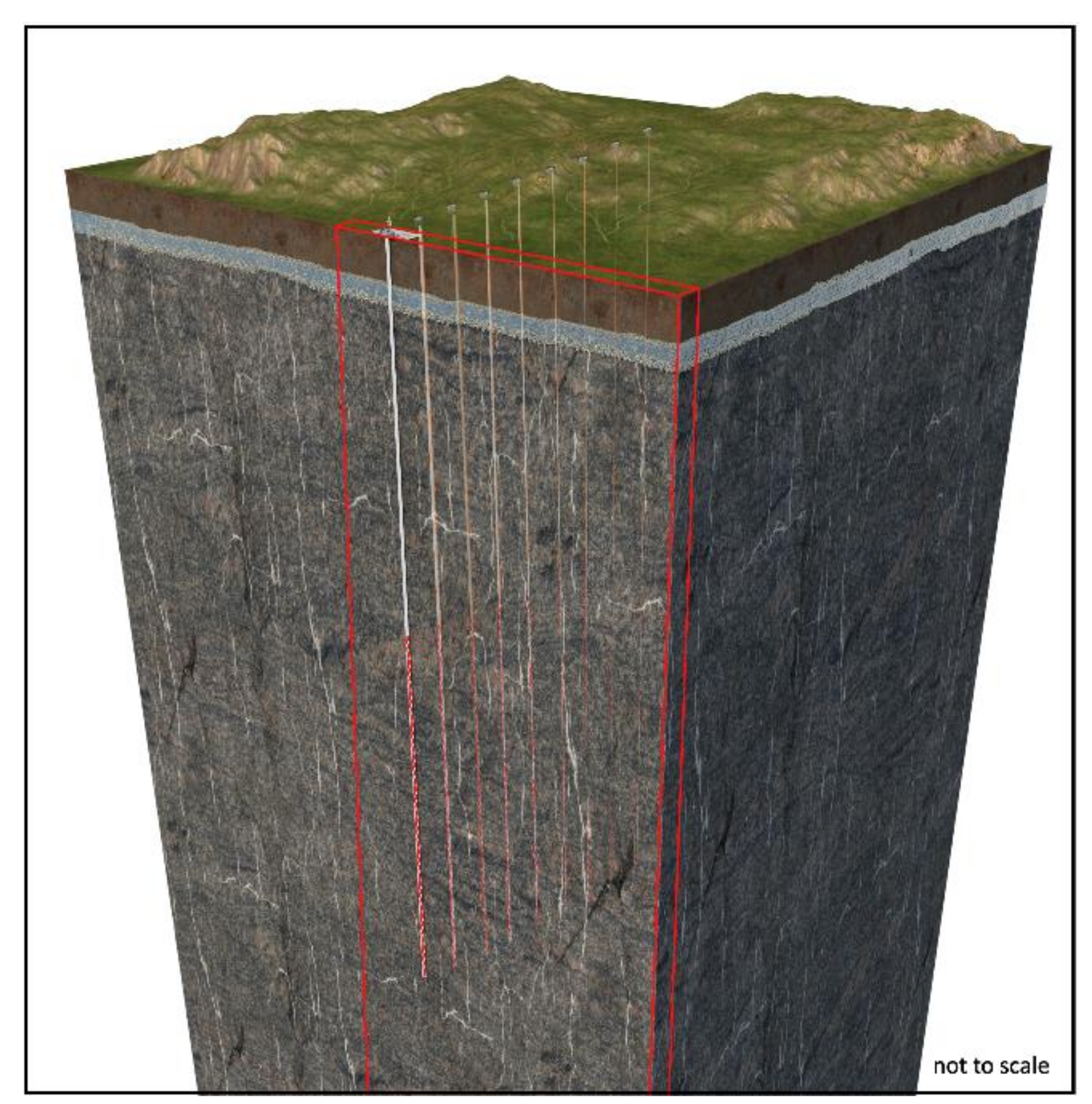
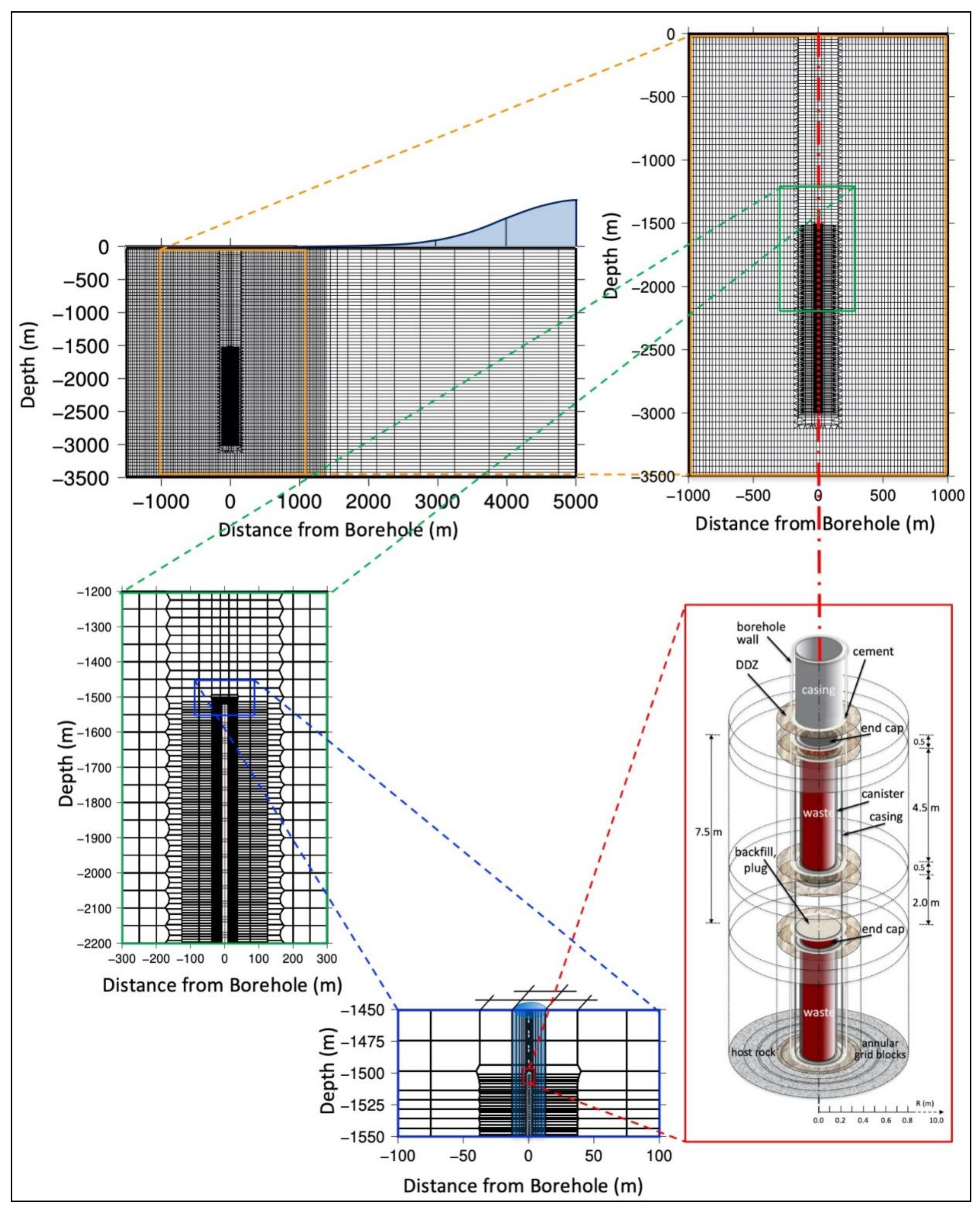
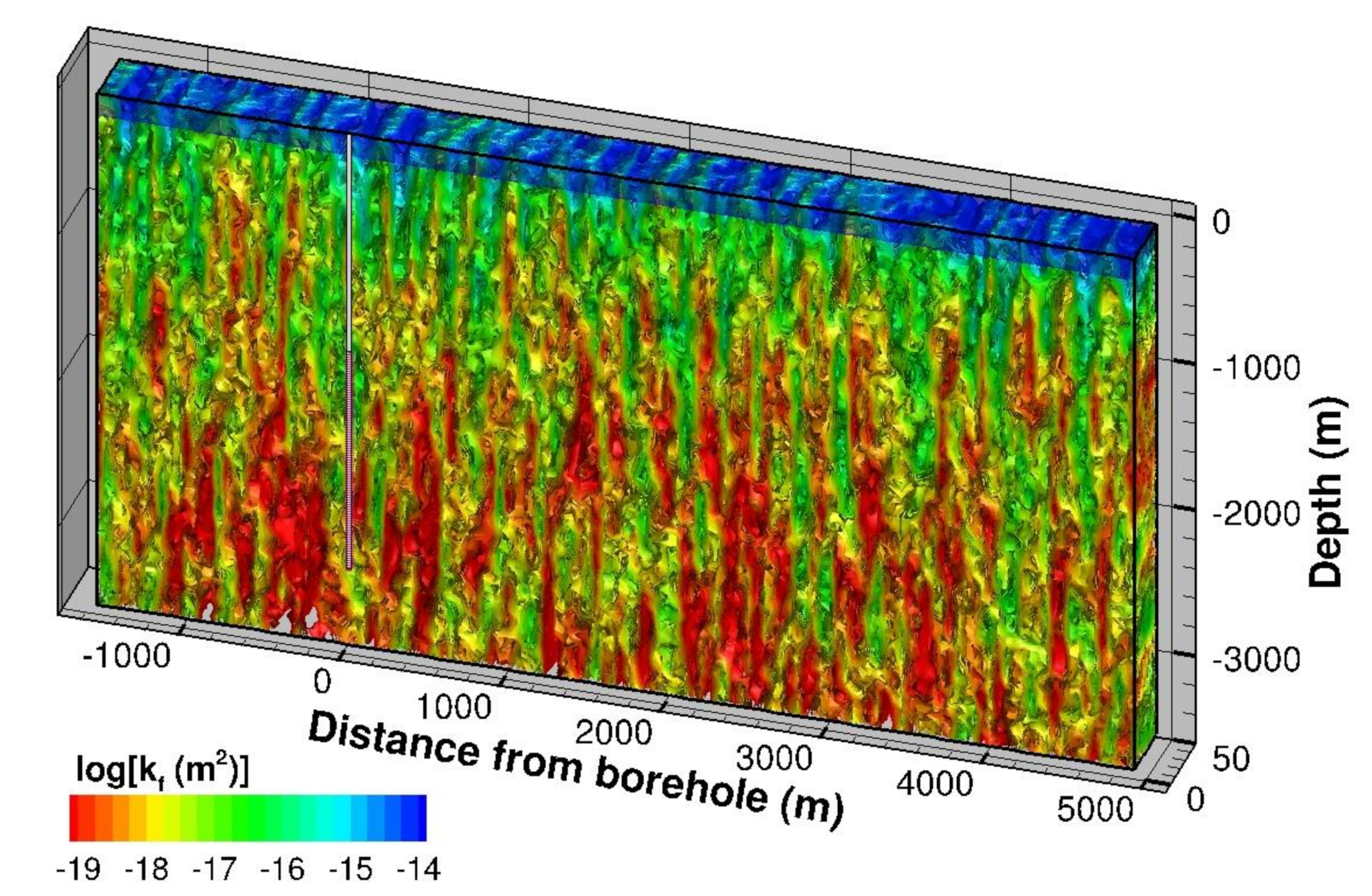
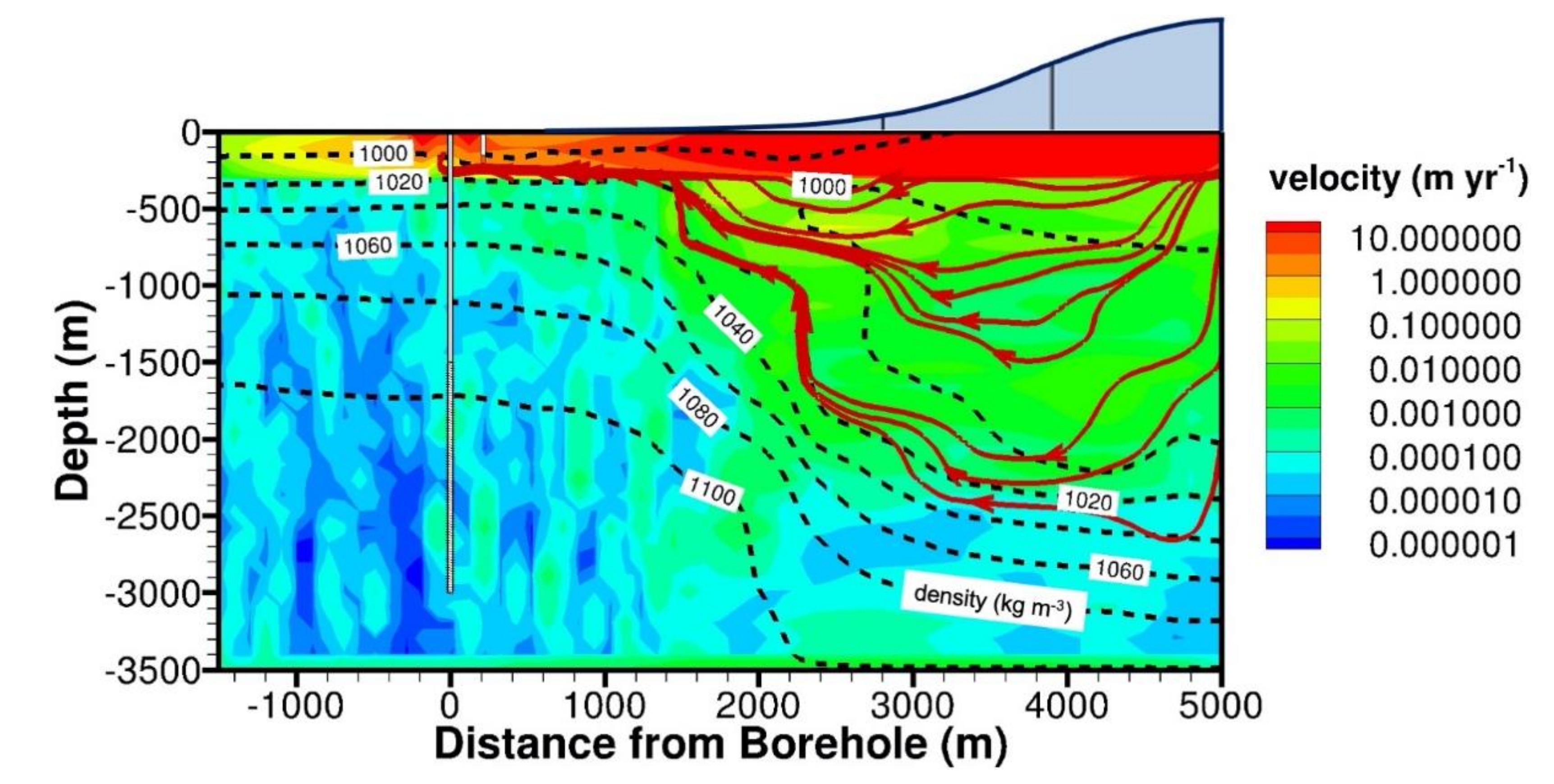
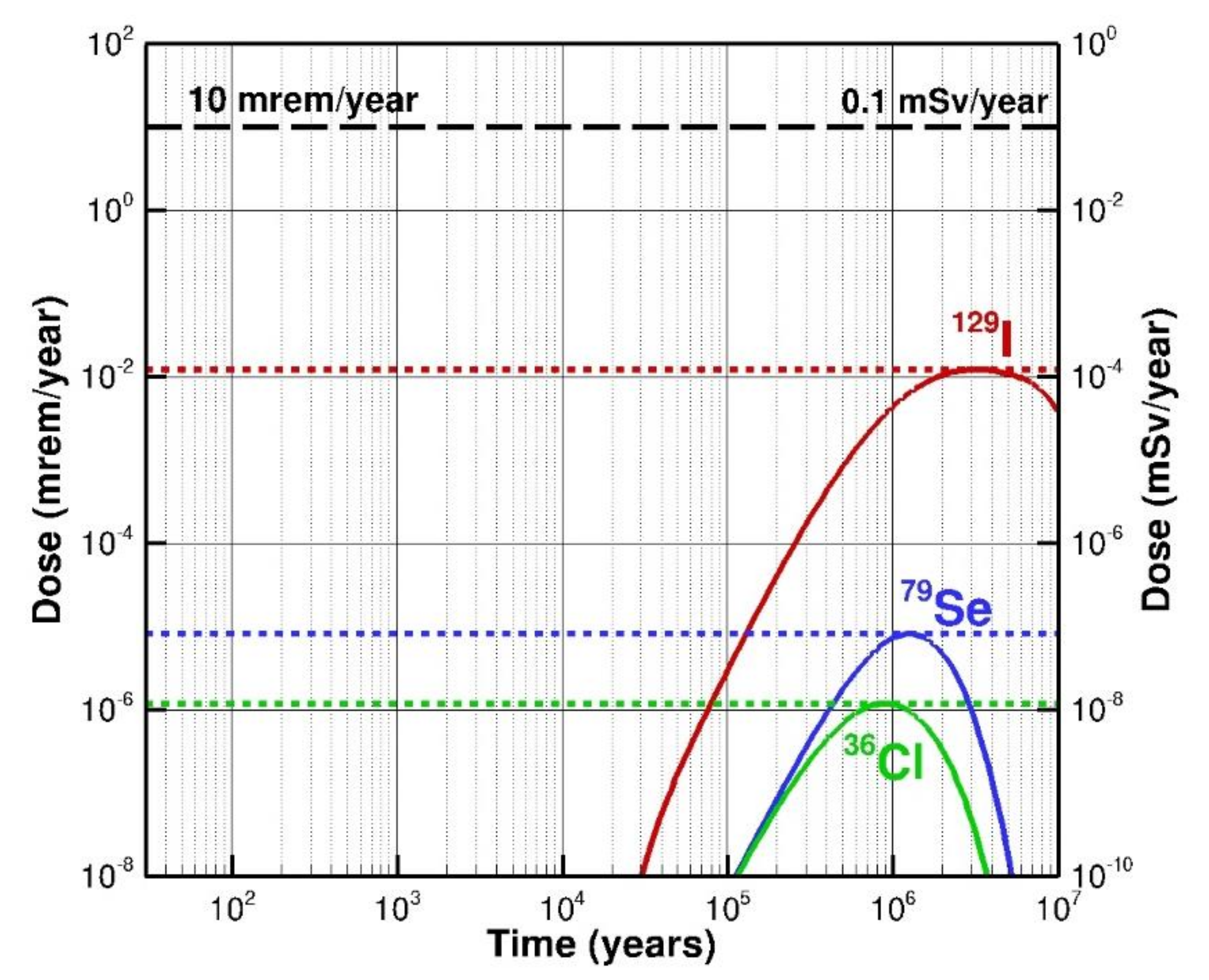

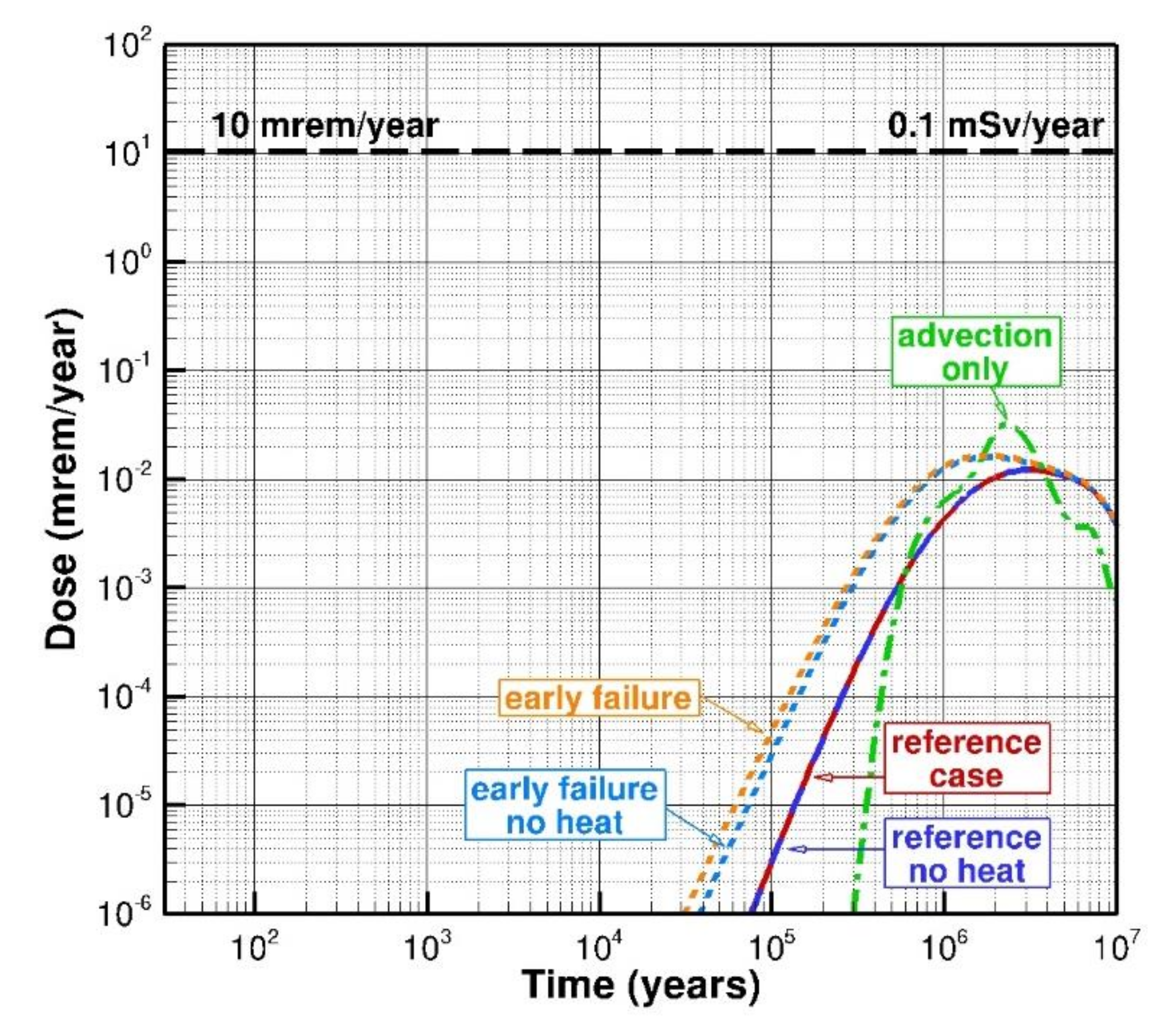
| Radio-Isotope | Half-Life (Years) | Inventory 1 (g/MTIHM) | Inventory 2 (g/Canister) | Activity 3 (Bq/Canister) | Specific Activity (Bq kg−1) | Dose Coefficient 4 (Sv Bq−1) | Instant Release Fraction 5(%) |
|---|---|---|---|---|---|---|---|
| 129I | 1.57 × 107 | 313. | 136. | 8.88 × 108 | 6.53 × 109 | 1.10 × 10−7 | 16 |
| 79Se | 2.95 × 105 | 10.5 | 4.57 | 2.59 × 109 | 5.68 × 1011 | 2.90 × 10−9 | 11 |
| 99Tc | 2.11 × 105 | 1280. | 556. | 3.52 × 1011 | 6.33 × 1011 | 6.40 × 10−10 | 11 |
| 36Cl | 3.01 × 105 | 0.501 | 0.218 | 2.66 × 108 | 1.22 × 1012 | 9.30 × 10−10 | 16 |
| 245Cm | 8.50 × 103 | 9.54 | 4.15 | 2.64 × 1010 | 6.35 × 1012 | 2.15 × 10−7 | 0 |
| 241Am | 4.32 × 102 | 1250. | 543. | 6.91 × 1013 | 1.27 × 1014 | 2.00 × 10−7 | 0 |
| 237Np | 2.14 × 106 | 1240. | 539. | 1.40 × 1010 | 2.60 × 1010 | 1.11 × 10−7 | 0 |
| 233U | 1.59 × 105 | 0.014 | 0.006 | 2.17 × 106 | 3.57 × 1011 | 5.10 × 10−8 | 0 |
| 229Th | 7.34 × 103 | <0.001 | <0.001 | 2.18 × 104 | 7.87 × 1012 | 6.13 × 10−7 | 0 |
| Parameter | Unit | Material | Value | Note |
|---|---|---|---|---|
| permeability, k | m2 | waste | 10−20 | Uranium dioxide pellets |
| canister | 10−24 | Increases log-linearly with time to reach 10−16 m2 after 10,000 years | ||
| casing | 10−24 | Increases log-linearly with time to reach 10−16 m2 after 50 years | ||
| backfill | 10−16 | Represents various porous materials for plugging, sealing, and backfilling the borehole; assumed to be fractured or degraded | ||
| concrete | 10−15 | Assumed to be fractured or degraded | ||
| fracture | see note | Depth-dependent mean permeability of fracture network continuum [73]: ; locally modified using geostatistical model (see Section 3.5) | ||
| matrix | 10−20 | Matrix continnum; dual-permeability approach | ||
| aquifer | 10−12 | Vertical permeability is 10−13 m2 | ||
| DDZ | 10−15 | Drilling disturbed zone (DDZ); thickness assumed to be half of the drillhole radius | ||
| porosity, | % | waste | 40 | Includes space between fuel assembly and canister wall |
| canister | 10 | Represents corrosion product | ||
| casing | 10 | Represents corrosion product | ||
| backfill | 20 | |||
| concrete | 20 | |||
| fracture | 0.2 | 10% porosity of 2% fracture continuum volume fraction | ||
| matrix | 1 | |||
| compressibility, | Pa−1 | all | 10−9 | Pore compressibility, |
| expansivity, | °C−1 | all | 10−5 | Pore thermal expansivity, |
| thermal conductivity, λ | W m−1 °C−1 | waste canister casing | 40 40 40 | |
| backfill | 1 | |||
| geomaterials | 2 | |||
| heat capacity, | J kg−1 °C−1 | waste canister casing | 500 500 500 | |
| geomaterials | 900 | |||
| density, | kg m−3 | canister casing | 7000 7000 | |
| geomaterials | 2700 | Grain density | ||
| tortuosity, | m m−1 | all | see note | Related to porosity () [80]; for canister and casing, prior to breach |
| FWDR | yr−1 | waste | 10−5 | Fractional waste degradation rate [82] |
| pumping rate, q | kg s−1 | well | 0.317 | Leads to biosphere dilution factor consistent with IAEA’s Example reference biosphere ERB 1B [41] |
| Isotope | Oxidation State 1 | Diffusion Coefficient 2 (m2 s−1) | Sorption Coefficient 3 (m3 kg−1) | Solubility Limit 4(mol L−1) |
|---|---|---|---|---|
| 129I | –I | 2.0 × 10−9 | 0.0 | n/a |
| 79Se | –II, IV, VI | 1.0 × 10−9 | 0.0 | 2.00 × 10−5 |
| 99Tc | IV | 1.9 × 10−9 | 0.3 | 3.95 × 10−7 |
| 36Cl | –I | 2.0 × 10−9 | 0.0 | n/a |
| 245Cm | III | 6.2 × 10−10 | 1.0 | 2.00 × 10−6 |
| 241Am | III | 6.2 × 10−10 | 1.0 | 6.00 × 10−6 |
| 237Np | IV | 6.0 × 10−10 | 1.0 | 5.99 × 10−6 |
| 233U | IV | 4.1 × 10−10 | 1.0 | 9.50 × 10−10 |
| 229Th | IV | 2.5 × 10−10 | 1.0 | 4.00 × 10−7 |
Publisher’s Note: MDPI stays neutral with regard to jurisdictional claims in published maps and institutional affiliations. |
© 2021 by the authors. Licensee MDPI, Basel, Switzerland. This article is an open access article distributed under the terms and conditions of the Creative Commons Attribution (CC BY) license (https://creativecommons.org/licenses/by/4.0/).
Share and Cite
Finsterle, S.; Muller, R.A.; Grimsich, J.; Bates, E.A.; Midgley, J. Post-Closure Safety Analysis of Nuclear Waste Disposal in Deep Vertical Boreholes. Energies 2021, 14, 6356. https://doi.org/10.3390/en14196356
Finsterle S, Muller RA, Grimsich J, Bates EA, Midgley J. Post-Closure Safety Analysis of Nuclear Waste Disposal in Deep Vertical Boreholes. Energies. 2021; 14(19):6356. https://doi.org/10.3390/en14196356
Chicago/Turabian StyleFinsterle, Stefan, Richard A. Muller, John Grimsich, Ethan A. Bates, and John Midgley. 2021. "Post-Closure Safety Analysis of Nuclear Waste Disposal in Deep Vertical Boreholes" Energies 14, no. 19: 6356. https://doi.org/10.3390/en14196356
APA StyleFinsterle, S., Muller, R. A., Grimsich, J., Bates, E. A., & Midgley, J. (2021). Post-Closure Safety Analysis of Nuclear Waste Disposal in Deep Vertical Boreholes. Energies, 14(19), 6356. https://doi.org/10.3390/en14196356






